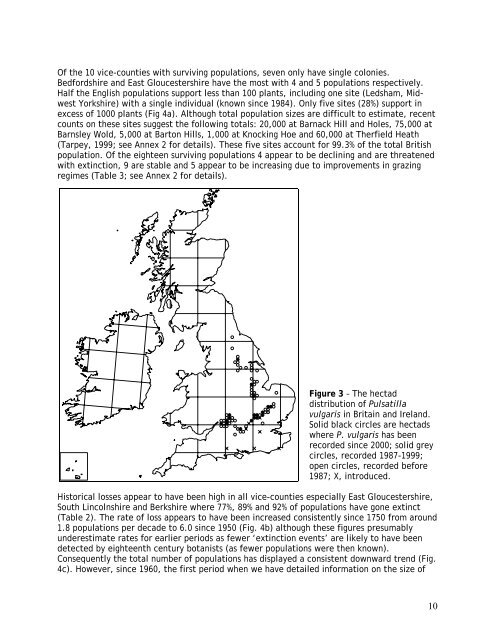Pulsatilla vulgaris (L.) Mill. - Plantlife
Pulsatilla vulgaris (L.) Mill. - Plantlife
Pulsatilla vulgaris (L.) Mill. - Plantlife
Create successful ePaper yourself
Turn your PDF publications into a flip-book with our unique Google optimized e-Paper software.
Of the 10 vice-counties with surviving populations, seven only have single colonies.<br />
Bedfordshire and East Gloucestershire have the most with 4 and 5 populations respectively.<br />
Half the English populations support less than 100 plants, including one site (Ledsham, Midwest<br />
Yorkshire) with a single individual (known since 1984). Only five sites (28%) support in<br />
excess of 1000 plants (Fig 4a). Although total population sizes are difficult to estimate, recent<br />
counts on these sites suggest the following totals: 20,000 at Barnack Hill and Holes, 75,000 at<br />
Barnsley Wold, 5,000 at Barton Hills, 1,000 at Knocking Hoe and 60,000 at Therfield Heath<br />
(Tarpey, 1999; see Annex 2 for details). These five sites account for 99.3% of the total British<br />
population. Of the eighteen surviving populations 4 appear to be declining and are threatened<br />
with extinction, 9 are stable and 5 appear to be increasing due to improvements in grazing<br />
regimes (Table 3; see Annex 2 for details).<br />
Figure 3 – The hectad<br />
distribution of <strong>Pulsatilla</strong><br />
<strong>vulgaris</strong> in Britain and Ireland.<br />
Solid black circles are hectads<br />
where P. <strong>vulgaris</strong> has been<br />
recorded since 2000; solid grey<br />
circles, recorded 1987-1999;<br />
open circles, recorded before<br />
1987; X, introduced.<br />
Historical losses appear to have been high in all vice-counties especially East Gloucestershire,<br />
South Lincolnshire and Berkshire where 77%, 89% and 92% of populations have gone extinct<br />
(Table 2). The rate of loss appears to have been increased consistently since 1750 from around<br />
1.8 populations per decade to 6.0 since 1950 (Fig. 4b) although these figures presumably<br />
underestimate rates for earlier periods as fewer ‘extinction events’ are likely to have been<br />
detected by eighteenth century botanists (as fewer populations were then known).<br />
Consequently the total number of populations has displayed a consistent downward trend (Fig.<br />
4c). However, since 1960, the first period when we have detailed information on the size of<br />
10

















